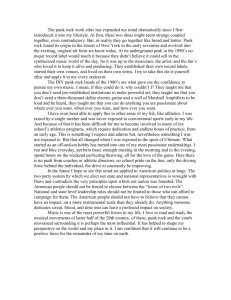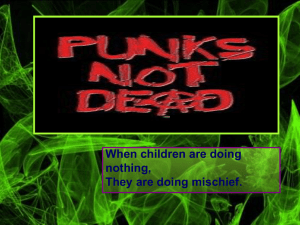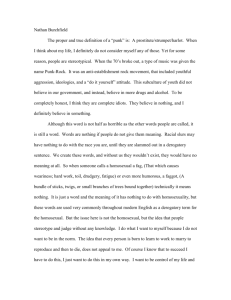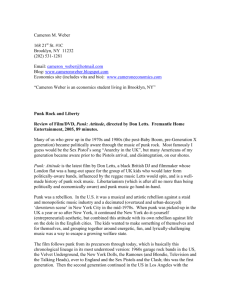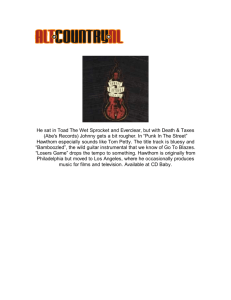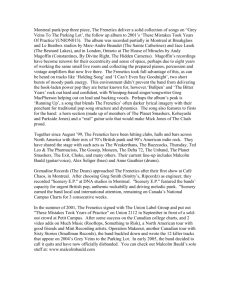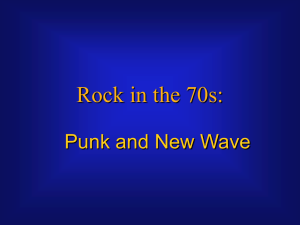Introduction - Fantagraphics Books
advertisement
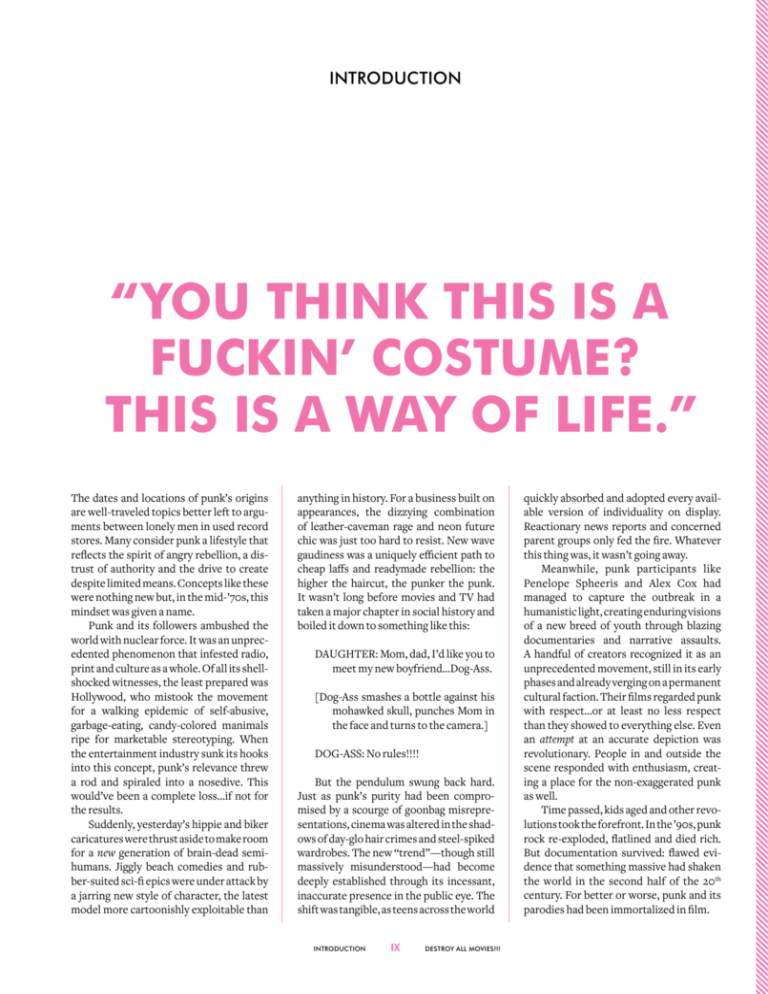
Introduction “You think this is a fuckin’ costume? This is a way of life.” The dates and locations of punk’s origins are well-traveled topics better left to arguments between lonely men in used record stores. Many consider punk a lifestyle that reflects the spirit of angry rebellion, a distrust of authority and the drive to create despite limited means. Concepts like these were nothing new but, in the mid-’70s, this mindset was given a name. Punk and its followers ambushed the world with nuclear force. It was an unprecedented phenomenon that infested radio, print and culture as a whole. Of all its shellshocked witnesses, the least prepared was Hollywood, who mistook the movement for a walking epidemic of self-abusive, garbage-eating, candy-colored manimals ripe for marketable stereotyping. When the entertainment industry sunk its hooks into this concept, punk’s relevance threw a rod and spiraled into a nosedive. This would’ve been a complete loss…if not for the results. Suddenly, yesterday’s hippie and biker caricatures were thrust aside to make room for a new generation of brain-dead semihumans. Jiggly beach comedies and rubber-suited sci-fi epics were under attack by a jarring new style of character, the latest model more cartoonishly exploitable than anything in history. For a business built on appearances, the dizzying combination of leather-caveman rage and neon future chic was just too hard to resist. New wave gaudiness was a uniquely efficient path to cheap laffs and readymade rebellion: the higher the haircut, the punker the punk. It wasn’t long before movies and TV had taken a major chapter in social history and boiled it down to something like this: DAUGHTER: Mom, dad, I’d like you to meet my new boyfriend…Dog-Ass. [Dog-Ass smashes a bottle against his mohawked skull, punches Mom in the face and turns to the camera.] DOG-ASS: No rules!!!! But the pendulum swung back hard. Just as punk’s purity had been compromised by a scourge of goonbag misrepresentations, cinema was altered in the shadows of day-glo hair crimes and steel-spiked wardrobes. The new “trend”—though still massively misunderstood—had become deeply established through its incessant, inaccurate presence in the public eye. The shift was tangible, as teens across the world Introduction IX Destroy All Movies!!! quickly absorbed and adopted every available version of individuality on display. Reactionary news reports and concerned parent groups only fed the fire. Whatever this thing was, it wasn’t going away. Meanwhile, punk participants like Penelope Spheeris and Alex Cox had managed to capture the outbreak in a humanistic light, creating enduring visions of a new breed of youth through blazing documentaries and narrative assaults. A handful of creators recognized it as an unprecedented movement, still in its early phases and already verging on a permanent cultural faction. Their films regarded punk with respect…or at least no less respect than they showed to everything else. Even an attempt at an accurate depiction was revolutionary. People in and outside the scene responded with enthusiasm, creating a place for the non-exaggerated punk as well. Time passed, kids aged and other revolutions took the forefront. In the ’90s, punk rock re-exploded, flatlined and died rich. But documentation survived: flawed evidence that something massive had shaken the world in the second half of the 20th century. For better or worse, punk and its parodies had been immortalized in film. “This is a baaad Idea…” In winter of 2004, I was working at The Grand Illusion Cinema, Seattle’s longest running (and tiniest) independent movie house. After much searching, we’d located the only known 35mm film print of 1984’s Suburbia, a drama about the lives of LA’s homeless punk teens. The show took place at midnight during an ice storm. A modest audience filed in and the lights went down. Over the course of the screening, I realized two things: 1) This was a genuinely sympathetic portrayal of an overlooked section of society. 2) It was the best movie I’d ever seen. This wasn’t the first time I’d watched it; the tape was a battered staple of video stores throughout my high school years, and many of the kids I grew up with could recite long stretches of the script. But while experiencing it on screen with a group of people that had braved the elements to be there, I realized how important the movie was. Writer/director Penelope Spheeris presented marginalized youths without pandering to the public’s perception of them. The non-actors exhibited a legitimate sadness, and the family these characters created felt more functional than most actual families I knew. I locked up the theater, went home and watched my own beat-up Suburbia VHS tape the following afternoon. Two weeks later, The Grand Illusion ran spazzoid masterpiece Joysticks. My best friend Bryan Connolly drove an hour for the screening despite the fact that neither of us had seen the film before. We grabbed our seats in anticipation of some highgrade, lowbrow ’80s arcade hijinks. The movie was all we had hoped for, but suddenly rocketed to the stratosphere with the appearance of one man: Jon Gries as “King Vidiot.” This rampaging subhuman lunatic burst into the film with a rabid intensity that can’t be described, his pink and blue hair blazing across the screen as he shrieked his every line. Band pins shone off his leather jacket and braces hung from his plaid pants. At his side was a new wave army of female Vidiot disciples, emitting Pac-Man noises as they skittered in tandem robotic shuffles. We were mesmerized. Characters like this had been an unstoppable force in ’80s cinema, and here was the most severe example of the form. Throughout the rest of the movie, King Vidiot sporadically reappeared to chew up the scene and vanish. The other actors looked shocked by Gries’ performance, barely able to swap dialogue with him without rearing back in confused terror. When Joysticks ended, half the audience (about seven people) stayed behind to discuss what they’d just seen. It was decided that King Vidiot embodied the anti-intellectual excitement that defined the era’s party comedies. He was a walking definition of what made movies fun. Just as impressively, he was a hilariously inaccurate effigy of punk, highlighted and accessorized beyond recognition. This was no longer a man; this was a deeply entertaining, beautifully executed error. Destroy All Movies!!! X Introduction Suburbia and Joysticks were made in the same year in the same city for the same age demographic. Both films even tackled similar subjects: youths vs. adults, triumph over adversity and maligned punks. But where one movie compellingly showcases the latter as struggling victims, the other presents them as painted berserkers who’d piledrive their grandma for a hot dog. Either way, the viewer wins. Bryan and I started swapping hazily remembered movie punk moments from our childhoods. The list expanded indefinitely, from comedies (Howard the Duck) to action films (The Terminator) to fullscale rebellion fantasies (Rock ‘n’ Roll High School). Soon our list had grown past 50 titles and we were in a fever. These characters had burned themselves into our minds and lay dormant for years, just to erupt in a frenzied volley of nostalgia. Then it happened. “We should write a book about every movie that ever had a punk in it!” How hard could it be? We’d come up with a good number off the top of our heads, and there couldn’t possibly be all that many more…could there? Our plan was simple: go to the local video store, note likely titles and take home the first few for viewing. Fortunately, that store was Scarecrow Video, an independently owned landmark that’s the largest video provider in America (possibly the world), boasting almost 100,000 feature films from across the globe. We showed up as they opened, clutching spiral notebooks. Bryan broke off for the comedy room and I headed for horror. We both started at “A,” pulling each tape from the wall and examining it for any signs of punk/new wave likelihood. Next we started at opposite ends of the action section, meeting at the middle with a tired sigh. Ten hours and no meals later, Scarecrow closed and we retreated. Fixation had taken hold. The next morning, we were back before they unlocked the doors. We scanned thousands of display boxes in drama, sci-fi and the store’s colossal directors section. Previously unconsidered areas were ransacked: instructional, stage adaptations, even France. Our notebooks filled with countless scrawled titles of every movie that could conceivably take place in a major city, a high school or a prison. By the end of the second assault, we’d manhandled every single movie in the store that wasn’t an opera or a Western (though we’d discover a punk in one of those later). Our fingers were black with VHS dust and our tattered pages were overflowing. Bryan had caught a cold… probably from the goddamn kids section. We returned home and laid out our papers, staring at a list of roughly 2000 movies. At this point, less courageous—or more intelligent­—men would have looked at the road ahead and turned away. We forged on. The following weekend, he returned to Scarecrow for anything we might have missed, while I swept other stores for additional titles. Bryan began online research, at first via the Internet Movie Database, and then through any site that mentioned “punk” and “movie” on the same page. Several of the titles we unearthed were seemingly unavailable anywhere, while others could only be ordered as expensive, undecipherable foreign bootlegs. We scavenged small-town rental stores for forgotten gems while sadly watching the Video Age breathe its last. Meanwhile, the Maybe List grew beyond anything we’d imagined. We divided it up and got to work. Scarecrow Video was an invaluable resource, allowing us full run of their stock at no charge. On dozens of occasions, Bryan and I would leave with several Introduction XI Destroy All Movies!!! garbage bags full of tapes slung over our shoulders like two VHS-obsessed Santas. When not at work, we’d spend full days sifting through unwatchable garbage in the hopes of spotting a hint of colored hair or a combat boot. During a party or street scene, the film would be paused and the screen scrutinized for any hint of possible punkery. Ninety percent of what we viewed contained nothing we needed; the vast majority of the characters credited as “Punk” on IMDB were just standard street thugs, greasy bikers or Caucasoid hip-hop chumps. End tape, frown, rewind, eject, next. Others entered the battle. Scarecrow’s Spenser Hoyt began carting home dusty videos by the carload. Kier-la Janisse tracked down completely unseen rarities. Fellow movie masochists heeded the battle cry from Chicago (Simon Czerwinskyj) to New Zealand (Ant Timpson). Eventually, we’d formed a network of people that were fiercely dedicated to the most self-abusive, ridiculous, impossible film reference book of all time. “Thanks for killing my mom.” Punk isn’t tangible, and those that flaunt its standard fashions are by no means intrinsically linked to the movement. Still, as we started to scour cinema’s lowest moments, it became apparent that we needed to establish some sort of criteria. We’d set out to document punks as they were represented in movies, and in many cases, a bright green spiked hairdo blew the whistle. But it wasn’t always that easy. After much discussion on what would earn a character’s inclusion in the book, we agreed that the punk(s) must be visually identifiable and/or the character(s) must express a strong dedication to some variation of the punk lifestyle (new wave, straight edge, etc). This weeded out metalheads, back-alley bruisers, dreadlocked groovers and zipper-vested “Beat It” extras. Weepy goths, industrial wasteoids and blow-dried Duran Duran mall-crawlers would have to show extra gumption to qualify. Some blue-collar skinheads toed the line while others were penalized for suckling a cleaner, militaristic teat. The mohawk has long been The Great Punk Indicator, but is sometimes worn by non-applicable combat-crazed steroid warriors (Street Fighter) and tanned muscleheads (South Beach Academy). Even heavy-hitting heroes like Travis Bickle and Mr. T were excluded, as their methods of personal expression either preceded punk or existed on an entirely separate plane (T has stated to the press that his hairstyle is inspired by the Mandika tribe and he has no interest in any type of rock music). Also, if an actor personally is—or has at any time been—a punk but is playing a non-punk character (i.e. Henry Rollins in Lost Highway or Lee Ving in Clue), there’s no reason for that performance to be included here. Just as when Shaq played the title role in Kazaam, he was a genie, not a basketball player. This project had a starting point of 1974, when the term “Punk Rock” was coined to describe the evolution music was taking. We selected a cut-off date of 1999, allowing us a lengthy but finite span to draw from. The 21st century had seen no advancements in the field of punk, very few in anything else, and was deemed a lost cause. TV had been as much a driving force of punk mockery as the film industry. Initially, we planned to include televised offenses against the movement, but realized the scope was gargantuan and the materials would be even more difficult to find. Besides, look at how damn big this book is already. That being said, madeDestroy All Movies!!! XII Introduction for-TV movies and full-length TV specials released on home video are covered. We reviewed features from all countries, but the film had to be available in English, either subtitled or dubbed. However, if it wasn’t ever officially released on any home video format, it was still our duty to track it down. The only genre that was roundly excluded was anime. It’s boring and none of us wanted to watch it. The occasional crucial short is included (like The Last Pogo and Debt Begins at 20), but our primary aim was feature-length narratives and documentaries. Live rock videos that focused on a single music group were out, as were music video/clip collections. Though their output is not represented here, we give the greatest respect to companies like Target Video and Flipside who documented emerging scenes through live concert footage. “let’s go do some crImes.” This book celebrates great accomplishments, terrible insults and the people responsible for both. We strived to reverentially recall one of the most vital chapters in mankind’s cultural history as captured by daring innovators and cashcrazed fad vampires. Our ultimate hope is that Destroy All Movies!!! will entertain, but also stand as an archaeological record of a maligned but powerful pioneering force. What you’re holding is the result of over half a decade of bitter struggle. Enjoy it. Xiii deStroy all movieS!!! “NO RULES!!!!,” Zack Carlson Austin, TX Destroy All Movies!!! XIV FIRST FILM ON PAGE
